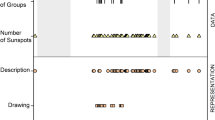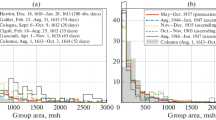Abstract
Although W. Brunner began to weight sunspot counts (from 1926), using a method whereby larger spots were counted more than once, he compensated for the weighting by not counting enough smaller spots in order to maintain the same reduction factor (0.6) as was used by his predecessor A. Wolfer to reduce the count to R. Wolf’s original scale, so that the weighting did not have any effect on the scale of the sunspot number. In 1947, M. Waldmeier formalized the weighting (on a scale from 1 to 5) of the sunspot count made at Zurich and its auxiliary station Locarno. This explicit counting method, when followed, inflates the relative sunspot number over that which corresponds to the scale set by Wolfer (and matched by Brunner). Recounting some 60,000 sunspots on drawings from the reference station Locarno shows that the number of sunspots reported was “over counted” by \({\approx}\,44~\%\) on average, leading to an inflation (measured by an effective weight factor) in excess of 1.2 for high solar activity. In a double-blind parallel counting by the Locarno observer M. Cagnotti, we determined that Svalgaard’s count closely matches that of Cagnotti, allowing us to determine from direct observation the daily weight factor for spots since 2003 (and sporadically before). The effective total inflation turns out to have two sources: a major one (15 – 18 %) caused by weighting of spots, and a minor source (4 – 5 %) caused by the introduction of the Zürich classification of sunspot groups which increases the group count by 7 – 8 % and the relative sunspot number by about half that. We find that a simple empirical equation (depending on the activity level) fits the observed factors well, and use that fit to estimate the weighting inflation factor for each month back to the introduction of effective inflation in 1947 and thus to be able to correct for the over-counts and to reduce sunspot counting to the Wolfer method in use from 1894 onwards.





















Similar content being viewed by others
Notes
A spot like a fine point is counted as one spot; a larger spot, but still without penumbra, gets the statistical weight 2, a smallish spot within a penumbra gets 3, and a larger one gets 5.
When an observer at his instrument on any given day records \(g\) groups of spots with a total of \(f\) single spots, without regard to their size, then the derived relative sunspot number for that day is \(r = k(10g+f)\).
The basis for the Zürich data about the frequency of sunspots is the daily Wolf Relative Sunspot Number \(r = k (10g + f)\) computed from the observed \(g\) and \(f\), where \(g\) is the number of sunspot groups, \(f\) is the total number of all the single spots present within those groups, and \(k\) is a constant depending on observer and instrument.
Wolf also counted a collection of spots within a common largish penumbra as just a single spot and thus did not take the structure and splitting of the umbra into account, and only included the smallest spots if they were visible at first glance on a sufficiently good quality image.
References
Balmaceda, L.A., Solanki, S.K., Krivova, N.A., Foster, S.: 2009, A homogeneous database of sunspot areas covering more than 130 years. J. Geophys. Res. 114, A07104. DOI .
Beck, R.: 1984, Zum Problem der Gruppeneinteilung von Sonnenflecken. In: Sonne – Mitteilungsblatt der Amateursonnenbeobachter 8, 64 ( www.leif.org/research/Beck-Rules-Groups-and-Spots.pdf ) [downloaded on 13 August 2016].
Brunner, W.: 1936, Zürich observatory. Terr. Magn. Atmos. Electr. 41(2), 210. DOI .
Brunner, W.: 1945, Tabellen und Kurven zur Darstellung der Häufigkeit der Sonnenflecken in den Jahren 1749 – 1944. Astron. Mitt. Eidgenöss. Sternwarte Zür. 145, 135.
Clette, F., Svalgaard, L., Vaquero, J.M., Cliver, E.W.: 2014, Revisiting the sunspot number – a 400-year perspective on the solar cycle. Space Sci. Rev. 186, 35. DOI .
Cortesi, S., Cagnotti, M., Bianda, M., Ramelli, R., Manna, A.: 2016, Sunspot observations and counting at specola solar ticinese in locarno since 1957. Solar Phys. 291, 3075. DOI .
Friedli, T.K.: 2009, Die Wolfsche Reihe der Sonnenfleckenrelativzahlen. In: Verbesserte Likelihood Ratio Tests zur Homogenitätsprüfung in struturelle Zustandsraummodellen, Südwestdeutcher Verlag für Hochschulschriften, Saarbrücken.
Kopecký, M., Kuklin, G.V., Růžičková-Topolová, B.: 1980, On the relative inhomogeneity of long-term series of sunspot indices. Bull. Astron. Inst. Czechoslov. 31, 267.
Lockwood, M., Owens, M.J., Barnard, L.: 2014, Centennial variations in sunspot number, open solar flux, and streamer belt width: 1. Correction of the sunspot number record since 1874. J. Geophys. Res. Space Phys. 119, 5172. DOI .
Ostrow, S.M., PoKempner, M.: 1952, The difference in the relationship between ionospheric critical frequencies and sunspot number for different sunspot cycles. J. Geophys. Res. 57(4), 473. DOI .
Pavai, V.S., Arlt, R., Dasi-Espuig, M., Krivova, N.A., Solanki, S.K.: 2015, Sunspot areas and tilt angles for solar cycles 7 – 10. Astron. Astrophys. 584, A73. DOI .
Svalgaard, L.: 2007, Calibrating the Sunspot Number using “the Magnetic Needle”. CAWSES Newsletter 4(1). http://www.leif.org/research/CAWSES - Sunspots.pdf [downloaded on 13 August 2016].
Svalgaard, L.: 2010, Updating the historical sunspot record. In: Cranmer, S.R., Hoeksema, J.T., Kohl, J.L. (eds.) SOHO-23: Understanding a Peculiar Solar Minimum, Astron. Soc. Pacific, San Francisco CS-428, 297.
Svalgaard, L.: 2012, How well do we know the sunspot number? In: Mandrini, C.H., Webb, D.F. (eds.) Comparative Magnetic Minima: Characterizing Quiet Times in the Sun and Stars, Proc. IAU Sympos. 286, Cambridge University Press, Cambridge, 15. DOI .
Svalgaard, L.: 2014. www.leif.org/research/The-Effect-of-Weighting-in-Counting-Sunspots-and-More.pdf [downloaded on 13 August 2016].
Svalgaard, L.: 2016, Reconstruction of Solar Extreme Ultraviolet Flux 1740 – 2015. Solar Phys. 291. DOI .
Svalgaard, L.: 2017, A Recount of Sunspot Groups on Staudach’s Drawings. Solar Phys. 292, 4. DOI .
Svalgaard, L., Schatten, K.H.: 2016, Reconstruction of the Sunspot Group Number: The Backbone Method. Solar Phys. 291. DOI .
Waldmeier, M.: 1938, Chromosphärische Eruptionen. I. Zeit. Astrophys. 16, 276.
Waldmeier, M.: 1948, 100 Jahre Sonnenfleckenstatistik. Astron. Mitt. Eidgenöss. Sternwarte Zür. 152, 1.
Waldmeier, M.: 1961, The Sunspot-Activity in the Years 1610 – 1960, Schulthess & Co., Swiss Federal Observatory, Zürich.
Waldmeier, M.: 1968, Die Beziehung zwischen der Sonnenflecken-relativzahl und der Gruppenzahl. Astr. Mitteil. Eidgn. Sternw. Zürich 285, 1.
Waldmeier, M.: 1978, Solar activity 1964 – 1976 (cycle no. 20). Astr. Mitteil. Eidgn. Sternw. Zürich 368, 1.
Wolf, R.: 1856, Beobachtungen der Sonnenflecken in den Jahren 1849 – 1855, Mittheil. über die Sonnenflecken I, 3.
Wolfer, A.: 1907, Die Häufigkeit und heliographische Verteilung der Sonnenflecken im Jahre 1906. Astron. Mitt. Eidgenöss. Sternwarte Zür. XCVIII, 10, 251.
Acknowledgements
We have benefited from participation in the four Sunspot Number Workshops ( http://ssnworkshop.wikia.com/wiki/Home ) and from discussions with the team at the WDC/SILSO. Sunspot data was supplied by WDC/SILSO, Royal Observatory of Belgium. We acknowledge with pleasure the use of drawings from Specola Solare Ticinese, Locarno ( http://www.specola.ch/e/drawings.html ). This study includes data from the synoptic program at the 150-Foot Solar Tower of the Mt. Wilson Observatory ( ftp://howard.astro.ucla.edu/pub/obs/drawings ). The Mt. Wilson 150-Foot Solar Tower is operated by UCLA, with funding from NASA, ONR and NSF, under agreement with the Mt. Wilson Institute. We thank a reviewer for prompting us to re-examine the contribution of William Brunner. LS thanks Stanford University for support.
Author information
Authors and Affiliations
Corresponding author
Ethics declarations
Disclosure of Potential Conflicts of Interest
The authors declare that they have no conflicts of interest.
Additional information
Sunspot Number Recalibration
Guest Editors: F. Clette, E.W. Cliver, L. Lefèvre, J.M. Vaquero, and L. Svalgaard
Rights and permissions
About this article
Cite this article
Svalgaard, L., Cagnotti, M. & Cortesi, S. The Effect of Sunspot Weighting. Sol Phys 292, 34 (2017). https://doi.org/10.1007/s11207-016-1024-9
Received:
Accepted:
Published:
DOI: https://doi.org/10.1007/s11207-016-1024-9




